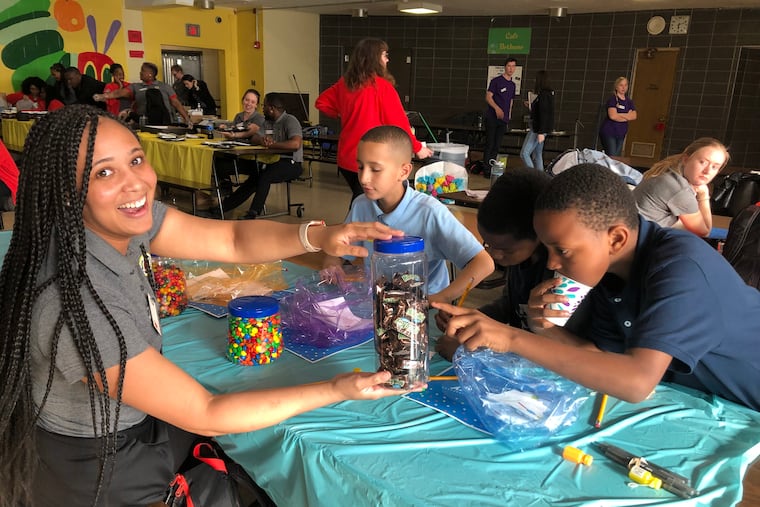Philly becoming a national model for how to make serving the community more common
Philly is trying to get rid of the misconception that dedicating a year to service is only for the privileged.

Students at Kensington Health Sciences Academy took a trip Tuesday to the National Museum of African American History and Culture in Washington. It was the kind of long day some students might use to justify skipping school the next morning.
But Kayla Allison was proud to say two Kensington students who in the past had been flagged for spotty attendance showed up Wednesday on time. Allison, a 23-year-old University of Pennsylvania graduate, had mentored them as a member of City Year Philadelphia, one of the largest programs under AmeriCorps, the federal initiative that pays young adults — typically between ages 18 and 28 — a stipend to serve local communities.
About 2,500 people make similar pledges each year in Philadelphia, committing to service programs in fields as varied as education, health, environment, and community development.
Other cities have noticed. As students were visiting the museum on Tuesday, Mayor Jim Kenney was just a few miles away in Washington, telling leaders from nearly 40 states, cities, and towns about his city’s approach to recruiting and deploying service corps members and talking about how the city is trying to expand such programs.
“Philadelphia is on the path to being a national model,” said Raabia Budhwani, an executive at Service Year Alliance, the national nonprofit that recruited Kenney to discuss Philadelphia’s efforts at a summit in partnership with the National League of Cities.
Like Allison, some of the service participants mentor students. Others help Philadelphians find housing or keep their homes. Some clean parks and plant vegetation to control storm-water runoff. The Kenney administration even considers them a weapon in the battle against the opioid crisis — assigning some AmeriCorps members to help prison inmates who have struggled with addiction continue to get treatment after they are released.
“For pretty much any issue you can think of that the city is facing, there are probably service members working to solve those problems,” said Amanda Gamble, Philadelphia’s chief service officer, who started her career as an AmeriCorps member working in city schools.
To attract more people into such programs, Philadelphia in July formed a committee of representatives from the School District, higher education, private companies, community groups, Pennsylvania’s state service commission, and the Corporation for National and Community Service — the federal agency that funds programs such as AmeriCorps — to think of ways to remove barriers keeping people from serving.
"In some spaces, doing a year of service feels like a privilege, because not everybody can take time off from a full-time, fully paid position,” Gamble said.
Over the last 25 years, more than 16,000 Philadelphians have served more than 21 million hours through AmeriCorps, according to the Corporation for National and Community Service. For participants currently active in various service programs, the agency is paying $9 million in federal funding and an additional $3.6 million for scholarships.
The federal funding is critical. And the city’s committee is also focused on how to educate Philadelphians about service opportunities and to work with local public and private-sector partners to get more benefits, transportation assistance, and other support for those looking to serve their communities.
Throughout Philadelphia, members stationed in city departments are “working on projects that probably otherwise wouldn’t get touched,” Gamble said. "They’re those ‘reach’ projects.”
Allison, who works with students in Kensington, followed in the footsteps of both her sisters, AmeriCorps alumnae. She said the program gave her the confidence to pursue her current career plan: teaching high school math and giving young students of color the role model she wished she’d had.
Three years ago, Service Year Alliance formed with the mission of making a year of paid, full-time service a common experience for young Americans — ideally, for one in four to have completed a service year.
Allison is on board with that mission. “I’m really a firm believer in the whole idea of ‘Where did you serve?’ I want that to be a [common] question people ask,” she said.
A little more than a year ago, 26-year-old Romeo McCloud wouldn’t have been able to answer that. He felt lost, having dropped out of college twice and jumping from one unfulfilling job to another. Then his girlfriend stumbled upon PowerCorpsPHL, a service and workforce development program for “disconnected young adults” like him.
“I gave it a shot and I came here and everything changed," he said.
Suddenly, he had professional role models who told him of the potential they saw in him. He developed untapped skills and plans to continue advocating for his North Philadelphia community.
“You get pushed to be the best version of yourself,” McCloud said. “I’ve always been a leader. I just didn’t know.”
He is now an assistant crew leader in the program after working for about six months on green storm-water infrastructure projects as a member. Where he comes from, second chances are rare. But in the program, he said, "you get a clean slate as a human being when you walk in.”
“You see so much growth," McCloud said, “in people nobody believed in.”